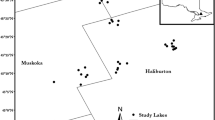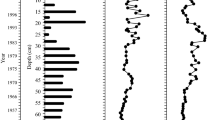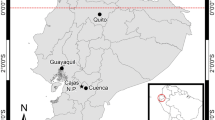Abstract
It is difficult to plan restoration projects or study the amount of disturbance in aquatic ecosystems if background conditions are not known. Zooplankton, especially cladocerans (water fleas), has proven highly useful as a reliable indicator of environmental change. Cladocerans preserve well in sediments and thus allow for the analysis of historical communities. To assess the stability of cladoceran communities in lakes with low human impact, we compared pre-industrial and modern cladoceran assemblages (top–bottom analysis) in 32 sub-Arctic lakes in NW Finnish Lapland. We used a dataset of measured environmental variables to determine their explanatory power on cladoceran assemblages. While cladoceran assemblages at the community level have remained relatively stable between the pre-industrial and modern samples, a clear change at the genus level was observed with a significant proportional increase in Bosmina (Eubosmina) spp. (Wilcoxon signed-rank test z = 2.75 p = 0.006). The amount of organic matter in the sediment [measured as loss on ignition (LOI)] explained the largest proportion of the variation in the cladoceran community. Since LOI is strongly correlated to climatic factors, the increased abundance of B. (Eubosmina) spp. may ultimately be related to climate warming. As the top–bottom approach is comprised of two temporal snapshots, it cannot provide the exact time of community change. This shortcoming is of special importance for restoration and management planning.




Similar content being viewed by others
References
Alric B, Jenny J-P, Berthon V, Arnaud F, Pignol C, Reyss J-L, Sabatier P, Perga M-E (2013) Local forcing affect lake zooplankton vulnerability and response to climate warming. Ecology 94:2767–2780
Amsinc SL, Strzelczak A, Bjerring R, Landkildehus F, Lauridsen TL, Christoffersen K, Jeppesen E (2006) Lake depth rather than fish planktivory determines cladoceran community structure in Faroese lakes—evidence from contemporary data and sediments. Freshw Biol 51:2124–2142
Anttila P, Virkkula A, Ruosteenoja K, Hakola H, Vestenius M, Ryyppö T, Hellen H, Leppänen S (2011) Assessment of the impacts of climate change on pollution transport to the arctic region-action 13 final report. Finnish Meteorological Institute, Helsinki
Battarbee RW (2000) Palaeolimnological approaches to climate change, with special regard to the biological record. Quat Sci Rev 19:107–124
Battarbee RW, Cameron NG, Golding P, Brooks SJ, Switsur R, Harkness D, Appleby P, Oldfield F, Thompson R, Monteith DT, McGovern A (2001) Evidence for Holocene climate variability from the sediments of a Scottish remote mountain lake. J Quat Sci 16:339–346
Bennion H, Batterbee R (2007) The European Union water framework directive: opportunities for palaeolimnology. J Paleolimnol 38:285–295
Bennion H, Battarbee RW, Sayer CD, Simpson GL, Davidson TA (2011) Defining reference and restoration targets for lake ecosystems using paleolimnology: a synthesis. J Paleolimnol 45:533–544
Birks HJB, Line JM (1992) The use of rarefaction analysis for estimating palynological richness from Quaternary pollen-analytical data. The Holocene 2:1–10
Bøhn T, Amundsen P-A (1998) Effects of invading vendace (Coregonus albula L.) on species composition and body size in two zooplankton communities of the Pasvik River System, northern Norway. J Plankton Res 20:243–256
Borsheim K, Andersen S (1987) Grazing and food size selection by crustacean zooplankton compared to production of bacteria and phytoplankton in a shallow Norwegian mountain lake. J Plankton Res 9:367–379
Brancelj A, Kernan M, Jeppesen E, Rautio M, Manca M, Sisko M, Alonso M, Stuchlik E (2009) Cladocera remains from the sediments of remote cold lakes: a study of 294 lakes across Europe. Adv Limnol 62:239–264
Bray JR, Curtis JT (1957) An ordination of the upland forest communities of southern Wisconsin. Ecol Monogr 27:325–349
Bredesen EL, Bos DG, Laird KR, Cumming BF (2002) A cladoceran-based paleolimnological assessment of the impact of forest harvesting on four lakes from the central interior of British Columbia, Canada. J Paleolimnol 28:389–402
Brooks JL, Dodson SI (1965) Predation, body size and composition of plankton. Science 150:28–35
Clarke KR (1993) Non-parametric multivariate analysis of changes in community structure. Aust J Ecol 18:117–143
IBM Corp (2013) IBM SPSS Statistics for Windows, Version 22.0. IBM Corp, Amonk
Desellas AM, Paterson AM, Sweetman JN, Smol JP (2011) Assessing the effects of multiple environmental stressors on zooplankton assemblages in boreal shield lakes since pre-industrial times. J Limnol 70:41–56
Donald DB, Vinebrooke RD, Anderson S, Syrgiannis J, Graham MD (2001) Recovery of zooplankton assemblages in mountain lakes from the effect of introduced sport fish. Can J Fish Aquat Sci 58:1822–1830
Eggermont H, Martens K (2011) Preface: cladocera crustaceans: sentinels of environmental change. Hydrobiologia 676:1–7
Eloranta AP, Kahilainen KK, Amundsen P-A, Kundsen R, Harrod C, Jones RI (2015) Lake size and fish diversity determine resource use and trophic position of a top predator in high-latitude lakes. Ecol Evol 5:1664–1675
Frey DG (1962) Cladocera from the Eemian interglacial of Denmark. J Paleontol 36:1133–1154
Frey DG (1987) The taxonomy and biogeography of the Cladocera. Hydrobiologia 145:5–17
Gulati RD, Pires LMD, Van Donk E (2008) Lake restoration studies: failures, bottlenecks and prospects of new ecotechnological failures. Limnologica 38:233–247
Hall DJ, Threlkeld ST, Burns CW, Crowley PH (1976) The size-efficiency hypothesis and the size structure of zooplankton communities. Ann Rev Ecol Syst 7:177–208
Hammer Ø, Harper DAT, Ryan PD (2001) PAST. Paleontological statistics software package for education and data analysis. Palaeontol Electron 4(1):9
Hettelingh J-P, Downing RJ, de Smet P (1992) The critical loads concept for the control of acidification. Stud Environ Sci 50:161–174
Hrbacek J, Dvorakova M, Korinek V, Prochazkova L (1961) Demonstration of the effect of fish stock on the species composition of zooplankton and the intensity of metabolism of the whole plankton association. Int Ver Theor Angew Limnol Verh 14:192–195
Janse JH, De Senerpont Domis LN, Scheffer M, Lijklema L, Van Liere L, Klinge M, Mooij WM (2008) Critical phosphorus loading of different types of shallow lakes and the consequences for management estimated with the ecosystem model PCLake. Limnologica 38:203–219
Jeppesen E, Nõges P, Davidson T, Haberman J, Nõges T, Blank K, Lauridsen T, Søndergaard M, Sayer C, Laugaste R, Johansson L, Bjerring R, Amsinck S (2011) Zooplankton as indicators in lakes: a scientific-based plea for including zooplankton in the ecological quality assessment of lakes according to the European Water Framework Directive (WFD). Hydrobiologia 676:279–297
Jeziorski A, Yan ND, Paterson AM, DeSellas AM, Turner MA, Jeffries DS, Keller B, Weeber RC, McNicol DK, Palmer ME, McIver K, Arseneau K, Ginn BK, Cumming BF, Smol JP (2008) The widespread threat of calcium decline in fresh waters. Science 322:1374–1377
Jeziorski A, Keller B, Dyer R, Paterson A, Smol J (2015) Differences among modern-day and historical cladoceran communities from the “Ring of Fire” lake region in northern Ontario: identifying responses to climate warming. Fund Appl Limnol 186:203–216
Johnsen G, Borsheim K (1988) Functional response and food selection of the water flea, Bosmina longispina. J Plankton Res 10:319–325
Johnsen GH, Raddum GG (1987) A morphological study of two populations of Bosmina longispina exposed to different predation. J Plankton Res 9:297–304
Kaplan MR, Wolfe AP, Miller AP (2002) Holocene environmental variability in southern Greenland inferred from lake sediments. Quat Res 58:149–159
Korhola A (1999) Distribution patterns of Cladocera in subarctic Fennoscandian lakes and their potential in environmental reconstruction. Ecography 22:357–373
Korhola A, Weckström J (2004) Paleolimnological studies in Arctic Fennoscandia and the Kola Peninsula (Russia). In: Pienitz R, Douglas MSV, Smol JP (eds) Long-term environmental change in Arctic and Antarctic lakes, vol 8. Kluwer Academic Publishers, Dordrecht, pp 381–418
Korhola A, Olander H, Blom T (2000) Cladoceran and chironomid assemblages as qualitative indicators of water depth in subarctic Fennoscandian lakes. J Paleolimnol 24:43–54
Korhola A, Sorvari S, Rautio M, Appleby PG, Dearing JA, Hu Y, Rose N, Lami A, Cameron NG (2002) A multi-proxy analysis of climate impacts on the recent development of subarctic Lake Saanajarvi in Finnish Lapland. J Paleolimnol 28:59–77
Korosi JB, Smol JP (2011) Distribution of cladoceran assemblages across environmental gradients in Nova Scotia (Canada) lakes. Hydrobiologia 663:83–99
Korosi JB, Smol JP (2012) A comparison of present-day and pre-industrial cladoceran assemblages from softwater Nova Scotia (Canada) lakes with different regional acidification histories. J Paleolimnol 47:43–54
Korovchinsky NM (2016) Redescription of Bythotrephes arcticus Lilljeborg, 1901 (Crustacea:Cladocera: Onychopoda) and confirmation of an independent species status of the distant Transcaucasian populations of the genus Bythotrephes Leydig. Zootaxa 4138:247–270
Korponai J, Varga KA, Lengre T, Papp I, Toth A, Braun M (2011) Paleolimnological reconstruction of the trophic state in Lake Balaton (Hungary) using Cladocera remains. Hydrobiologia 676:237–248
Kurek J, Korosi JB, Jeziorski A, Smol JP (2010) Establishing reliable minimum count sizes for cladoceran subfossils sampled from lake sediments. J Paleolimnol 44:603–612
Kuzmina Y, Leshko Y (2002) Hydrobiological effects of gathering reindeer at an arctic lake in Russia. Rangifer 13:39–40
Lotter A, Birks H, Hofmann W, Marchetto A (1997) Modern diatom, cladocera, chironomid, and chrysophyte cyst assemblages as quantitative indicators for the reconstruction of past environmental conditions in the Alps. 1. Clim J Paleolimnol 18:395–420
Louette G, Declerc S, Vandekerkhove J, De Meester J (2009) Evaluation of restoration measures in a shallow lake through a comparison of present day zooplankton communities with historical samples. Restor Ecol 17:629–640
Luoto T, Nevalainen PL, Sarmaja-Korjonen K (2013) Zooplankton (Cladocera) in assessments of biologic integrity and reference conditions: appliance of sedimentary assemblages from shallow boreal lakes. Hydrobiologia 707:173–185
Manca M, Torretta B, Comoli P, Amsinck SL, Jeppesen E (2007) Major changes in trophic dynamics in large, deep sub-alpine Lake Maggiore from 1940s to 2002: a high resolution comparative palaeo-neolimnological study. Freshwater Biol 52:2256–2269
Mantel N (1967) The detection of disease clustering and a generalized regression approach. Cancer Res 27:209–220
Michelutti N, Laing TE, Smol JP (2001) Diatom assessment of past environmental changes in lakes located near the Noril’sk (Siberia) smelters. Water Air Soil Poll 125:231–241
Michelutti N, Wolfe AP, Vinebrooke RD, Rivard B, Briner JP (2005) Recent primary production increases in arctic lakes. Geophys Res Lett 32:L19715
Milardi M, Siitonen S, Lappalainen J, Liljendahl A, Weckström J (2016) The impact of trout introductions on macro- and microinvertebrate communities in fishless boreal lakes. J Paleolimnol 55:273–287
Nesje A, Dahl SO (2001) The Greenland 8200 calendar years BP event detected in loss-on-ignition profiles of Norwegian lacustrine sediment sequences. J Quat Sci 16:155–166
Nevalainen L, Luoto TP (2012) Faunal (Chironomidae: Cladocera) responses to post-Little Ice Age climate warming in the high Austrian Alps. J Paleolimnol 48:711–724
O’Reilly CM, Sharma S, Gray DK, Hampton SE, Read JS, Rowley RJ, Schneider P, Lenters JD, McIntyre PB, Kraemer BM et al (2015) Rapid and highly variable warming of lake surface waters around the globe. Geophys Res Lett 42:10773–10781
Paatero J, Dauvalter V, Derome J, Lehto J, Pasanen J, Vesala T, Miettinen J, Makkonen U, Kyrö E, Jernström J, Isaeva L, Derome K (2008) Effects of Kola air pollution on the environment in the western part of the Kola Peninsula and Finnish Lapland. Finnish Meteorological Institute Reports 2008/6 Helsinki
Pace ML, Carpenter SR, Johnson RA, Kurtzweil JT (2013) Zooplankton provide early warning of a regime shift in a whole lake manipulation. Limnol Oceanogr 58:525–532
Persson L (1986) Effects if reduced interspecific competition on resource utilization in Perch (Perca fluviatilis). Ecology 67:355–364
Rautio M (2001) Zooplankton assemblages related to environmental characteristics in treeline ponds in Finnish Lapland. Arct Antarct Alp Res 33:289–298
Rautio M, Mariash H, Forsström L (2011) Seasonal shifts between autochthonous and allochthonous carbon contributions to zooplankton diets in a subarctic lake. Limnol Oceanogr 56:1513–1524
Rawcliffe R, Sayer CD, Woodward G, Grey J, Davidson TA, Jones JI (2010) Back to the future: using palaeolimnology to infer long-term changes in shallow lake food webs. Freshw Biol 55:600–613
Rühland K, Priesnitz A, Smol J (2003) Paleolimnological evidence from diatoms for recent environmental changes in 50 lakes across Canadian arctic treeline. Arct Antarct Alp Res 35:110–123
Rühling Å, Steinnes E (2002) Heavy metals in surface soil in Fennoscandia. NORD 2002/4 Nordic Council of Ministers, Copenhagen
Säisä M, Rönn J, Aho T, Björklund M, Pasanen P, Koljonen M-L (2008) Genetic differentiation among European whitefish ecotypes based on microsatellite data. Hereditas 145:69–83
Sarmaja-Korjonen K, Alhonen P (1999) Cladoceran and diatom evidence of lake-level fluctuations from a Finnish lake and the effect of aquatic-moss layers on microfossil assemblages. J Paleolimnol 22:277–290
Sarmaja-Korjonen K, Nyman M, Kultti S, Väliranta M (2006) Palaeolimnological development of Lake Njargajavri, northern Finnish Lapland, in a changing Holocene climate and environment. J Paleolimnol 35:65–81
Seppovaara O (1969) Nieriä (Salvelinus alpinus L.) ja sen kalataloudellinen merkitys suomessa. Suomen Kalatalous 37. Maataloushallitus, Helsinki
Shutner BJ, Schlesinger DA, Zimmerman AP (1983) Empirical predictors of annual surface water temperature cycles in North American lakes. Can J Fish Aquat Sci 40:1838–1845
Siitonen S (2005) Vesikirput kahden Kilpisjärven alueen järven viimeaikaisen kehityksen kuvaajina. MSc thesis. University of Helsinki, Helsinki
Siitonen S, Väliranta M, Weckström J, Juutinen S, Korhola A (2011) Comparison of Cladocera-based water-depth reconstruction against other types of proxy data in Finnish Lapland. Hydrobiologia 676:155–172
Simon M, Wünch C (1998) Temperature control of bacterioplankton growth in a temperate lake. Aquat Microb Ecol 16:119–130
Sinev AY (2009) Discrimination between two sibling species of Acroperus (Baird, 1843) from the Palearctic (Cladocera: Anomopoda: Chydoridae). Zootaxa 2176:1–21
Sinev AY, Dumont HJ (2016) Revision of the costata-group of Alona s. lato (Cladocera: Anomopoda: Chydoridae) confirms its generic status. Europ J Taxon 223:1–38
Smol JP (1992) Paleolimnology: an important tool for effective ecosystem management. J Aquat Ecosyst Health 1:49–58
Smol J, Wolfe A, Birks H, Douglas M, Jones V, Korhola A, Pienitz R, Ruhland K, Sorvari S, Antoniades D, Brooks S, Fallu M, Hughes M, Keatley B, Laing T, Michelutti N, Nazarova L, Nyman M, Paterson A, Perren B, Quinlan R, Rautio M, Saulnier-Talbot E, Siitonen S, Solovieva N, Weckström J (2005) Climate-driven regime shifts in the biological communities of arctic lakes. Proc Natl Acad Sci USA 102:4397–4402
Sorvari S, Korhola A (1998) Recent diatom assemblage changes in subarctic Lake Saanajärvi NW Finnish Lapland, and their paleoenvironmental implications. J Paleolimnol 20:205–215
Sorvari S, Korhola A, Thompson R (2002) Lake diatom response to recent Arctic warming in Finnish Lapland. Global Change Biol 8:171–181
Sprules WG, Carter JCH, Ramcharan CW (1984) Phenotypic associations in the Bosminidae (Cladocera): zoogeographic patterns. Limnol Oceanogr 29:161–169
Stenson JAE (1976) Significance of predator influences on composition of Bosmina spp. populations. Limnol Oceanogr 21:814–822
Sweetman JN, LaFace E, Ruhland KM, Smol JP (2008) Evaluating the response of Cladocera to recent environmental changes in lakes from the central Canadian Arctic treeline region. Arct Antarct Alp Res 40:584–591
Sweetman JN, Ruhland KM, Smol JP (2010) Environmental and spatial factors influencing the distribution of cladocerans in lakes across the central Canadian Arctic treeline region. J Limnol 69:76–87
Szeroczyńska K, Sarmaja-Korjonen K (2007) Atlas of subfossil cladocera from central and northern Europe. Friends of the Lower Vistula Society, Warzaw
Tammi J, Appelberg M, Beier U, Hesthagen T, Lappalainen A, Rask M (2003) Fish status survey of Nordic Lakes: effects of acidification, eutrophication and stocking activity on present fish species composition. Ambio 32:98–105
ter Braak CJF, Šmilauer P (2007–2012) Canoco reference manual and user’s guide: Software for 623 ordination version 50 Microcomputer power, Itaca
Tolonen A (1997) Size-specific food selection and growth in benthic whitefish (Coregonus lavaretus (L.), in a subarctic lake. Boreal Environ Res 2:387–399
European Union (2000) Directive 2000/60/EC of the European Parliament and the council of 23 October 2000 on establishing a framework for community action in the field of water policy. Eur J Commun L327:1–72
Van Damme K, Dumont HJ (2008) Further division of Alona Baird, 1843: separation and position of Coronatella Dybowski & Grochowski and Ovalona gen. n. (Crustacea: Cladocera). Zootaxa 1960:1–44
van Oldenborgh GJ (1999) Koninklijk Nederlands Meteorologisch Instituut (KNMI). KNMI Climate Explorer. http://climexp.knmi.nl/. Accessed on 1 Dec, 2015
Weckström J, Korhola A (2001) Patterns in the distribution, composition and diversity of diatom assemblages in relation to ecoclimatic factors in Arctic Lapland. J Biogeogr 28:31–45
Weckström J, Korhola A, Blom T (1997) The relationship between diatoms and water temperature in thirty subarctic Fennoscandian lakes. Arct Antarct Alp Res 29:75–92
Weckström J, Snyder JA, Korhola A, Laing TE, MacDonald GM (2003) Diatom inferred acidity history of 32 lakes on the Kola Peninsula, Russia. Water Air Soil Poll 149:339–361
Weckström J, Hanhijärvi ST, Forsström L, Kuusisto E, Korhola A (2014) Reconstructing lake ice cover in subarctic lakes using a diatom- based inference model. Geophys Res Lett 41:2026–2032
Wetzel RG (1992) Clean water: a fading resource. Hydrobiologia 243(244):21–30
Wilcoxon F (1945) Individual comparisons by ranking methods. Biom Bull 1:80–83
Willemse NW, Törnquist TE (1999) Holocene century-scale temperature variability from west Greenland lake records. Geology 27:580–584
Acknowledgements
This work was funded by Tellervo and Jussi Walden foundation. We thank Sanna Korkonen and Juha Niemistö for help in the field.
Author information
Authors and Affiliations
Corresponding author
Electronic supplementary material
Below is the link to the electronic supplementary material.
Rights and permissions
About this article
Cite this article
Leppänen, J., Siitonen, S. & Weckström, J. The stability of cladoceran communities in sub-arctic NW Finnish Lapland lakes. Polar Biol 40, 2211–2223 (2017). https://doi.org/10.1007/s00300-017-2135-y
Received:
Revised:
Accepted:
Published:
Issue Date:
DOI: https://doi.org/10.1007/s00300-017-2135-y




